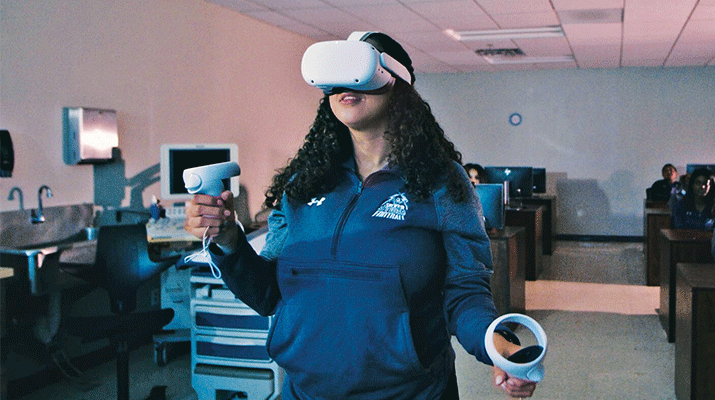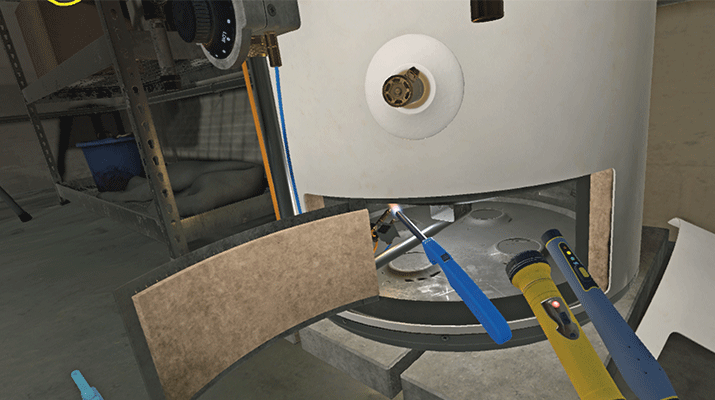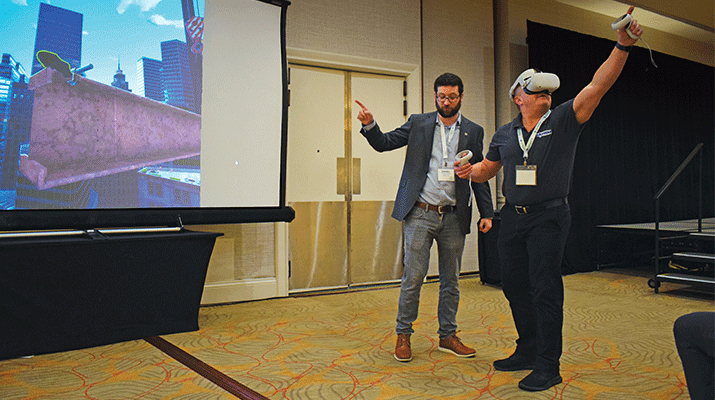Virtual reality to train proper protocol for routine propane tasks
Today, you’re learning how to light the pilot on a water heater. It’s something you expect to do often in your new job as a propane technician.
You’ve been learning the proper steps, and now it’s time to show what you know.

VR training is best suited for a classroom setting where students can learn from each other. (Photo courtesy of NextWave Safety Solutions, Inc.)
You start from the beginning and manage to light the pilot, but it flickers out. You try to light it again, and suddenly, you see a flash of flames. You had forgotten to turn off the control and wait five minutes for residual gas to dissipate before trying again.
But instead of panic, you feel relief. You’re just in a classroom. You take off the headset and see smiles. You hear words of encouragement from your classmates.
You made a mistake without paying the consequences that would ensue had this virtual reality (VR) experience been a real one. You learned an important lesson from that mistake, and so did the peers who watched you make it.
Soon, the Propane Education & Research Council (PERC) will make VR safety training experiences like this one available to all members of the propane industry.
PERC approved the creation of a VR training module during its July 2022 meeting in Lake Geneva, Wisconsin. The development of two VR modules is currently underway, supported by a budget of $150,000.
The first module, which instructs trainees on how to light a pilot, emerged from work AmeriGas accomplished with NextWave Safety Solutions, a developer of VR safety trainings based in New York City.
AmeriGas started working with NextWave just before the COVID-19 pandemic hit, according to Daniel Stein, director of client solutions at NextWave. At the time, AmeriGas was creating regional training centers and wanted to explore how VR might supplement instruction in locations less equipped to conduct extensive practical training.
AmeriGas later introduced the VR concept to PERC, and from there, PERC began to work with NextWave to improve upon and expand that initial pilot light module.
PERC and NextWave also will build a second module on filling a 100-pound cylinder.
The value of virtual reality
Not all tasks make sense to train in VR, but many tasks in the propane industry do.
Consider the many dangers associated with a basic task like driving, suggests Margaret Hiatt, educational content manager at PERC. A VR experience can provide feedback about the potential consequences of running a stop sign without putting a new trainee on the road and in danger. Add a bobtail to that equation. The expense and danger of practical training for a rollover event proves unfeasible. That preparation is possible in VR.

AmeriGas introduced the concept of the pilot light VR program and spearheaded its development with NextWave Safety Solutions. PERC will continue to work with NextWave to refine the instructional content for all industry members. (“Pilot Light Technician VR” NextWave Safety Solutions, Inc.)
“From an instructional standpoint, you want virtual reality for something dangerous, something expensive or something that’s complicated and you have to do it right the first time,” explains Hiatt. “It’s basically a safe space to fail.”
Stein would add to the list of something dangerous, expensive and complicated to train in a practical setting any material that’s boring to teach in traditional formats. While it’s important for instructors to clarify that VR safety training is not a game, says Stein, the experience does add liveliness to the learning environment, which can improve student engagement and retention of material.
Stein has seen the difference in NextWave’s work with construction professionals on Occupational Safety and Health Administration training. This important material is often delivered over a 30-hour period and involves a lot of PowerPoint slides.
“When we add a virtual component to the class, it’s like night and day,” says Stein. “Everyone in the classroom is aware, they’re listening, they’re often getting competitive with each other, and the lessons are sticky.”
VR safety training is best suited for a classroom setting where an expert instructor can coach individual students through the program while other students learn from watching the experience displayed on a monitor. However, PERC intends that its VR modules supplement, not replace, traditional classroom instruction, practical training and e-learning.
“VR is a great place to slide in between classroom training and hands-on training. That’s really the sweet spot,” says Hiatt.
Take the pilot light training, for example. Conventionally, a new propane industry employee would complete their e-learning or instructor-led training and then go out on the job with an experienced mentor who verbally communicates the instructions and potential dangers. With VR, the trainee can practice lighting a pilot after learning about the appropriate steps but before they go out in the field for on-the-job training.
“That’s the advantage our industry folks will have by utilizing this tool, the opportunity to practice those potentially dangerous situations that their employees may be exposed to in the real world and not rely on that on-the-job trainer who’s going to give them that warning, or worse yet, tell them a shortcut,” says Lyndon Rickards, director of safety and compliance at PERC. “[The trainee will] get to choose for themselves when they go through this virtual setting.”
VR safety training is also useful for remedial training in the event of an incident, adds Rickards.
When applied the right way, says Stein, VR safety training can reduce the overall time and cost of training while improving learning outcomes.
And those benefits are essential for any propane business to reap. Workers’ compensation injuries are costly for the employer, not to mention the potentially life-altering consequences of an injury for the employee, explains Rickards.
Potential pitfalls
VR programs are costly to develop, so it makes little sense to impart basic knowledge in a VR setting. Nor does it make sense to train for jobs that can just as easily be practiced in real life.
“If you can train effectively and safely practically, we never want you to stop doing that,” says Stein.

NextWave’s Daniel Stein, left, guides a propane industry member through a VR experience. (Photo by LP Gas staff)
Moreover, the longer it takes to demonstrate learning objectives in a VR setting, the more expensive the program. VR programs generally deliver short experiences that capture key learning moments.
Minimizing the length of the program also serves to reduce the likelihood of motion sickness. Some trainees with conditions like vertigo may find the VR experience unpleasant, so it’s important these trainings remain optional components of larger curriculums.
In addition to the costs of developing the program, companies must invest in significant infrastructure to get a VR training program off the ground.
“You have to buy the headsets. You have to buy the software. You have to train your instructors on how to use the new technology. It’s a pretty big ask, and it really only starts saving you time and money at scale,” explains Stein.
Industry involvement
The project team at PERC, which drew the participation of several propane marketers, won’t be ready to scale the industry’s VR programming until it sees how industry members receive the pilot light and cylinder fill trainings. It’s committed to ensuring a return on investment with two modules that simulate common, yet potentially dangerous tasks for propane technicians.
Team members serve as subject matter experts to ensure the programs are true to life and convey key learning objectives. They write scripts detailing proper protocol and take videos to show NextWave how a task should be performed.
NextWave takes that industry-specific information and applies the principles of effective VR training. The programs introduce a number of randomized “what if” scenarios to test safety knowledge and awareness.
In the pilot light program, for example, trainees are expected to perform a job safety analysis. They may see combustible laundry strewn about the water heater and should remove it before attempting to light the pilot. When filling a cylinder, failure to inspect the cylinder for corrosion could result in an uncontrolled release of propane in a virtual setting.
“A lot of that comes from experience from the group that’s working on it,” says Rickards. “We’ve all been out there in the basements of people’s homes or mechanical rooms and been able to see this stuff. So you take that real-life experience and bring it into this setting.”
These “what if” scenarios also provide an instructional benefit in the classroom. No two experiences in the module are exactly alike, expanding students’ opportunities to learn from each other and providing ample opportunities for retraining.
Not all experiences in VR should be true to life, though. Technicians don’t always face the consequences of unsafe behavior in real life, but the VR module triggers a negative consequence every time a mistake is made in the virtual setting.
“We can make sure that everyone is doing things properly because of that innate sense of immersion and fear in that we can create dangerous results for bad habits,” explains Stein.
When the programs are ready to roll out, industry members can expect a tutorial that teaches them how to use the headset, as well as the possibility of training on the headset at PERC’s annual Propane Education & Training Conference, says Hiatt.
Keep an eye out also for communications about the VR program in PERC newsletters and webinars in the months to come, adds Rickards.
More modules to come?
Opportunities to expand the use of VR training abound in the propane industry. Possibilities include but aren’t limited to:
⦁ Driving a bobtail.
⦁ Evacuating propane containers.
⦁ Filling containers.
⦁ Managing an uncontrolled release of propane.
⦁ Preparing for difficult workplace conversations and other soft skills.
⦁ Transporting containers.
















